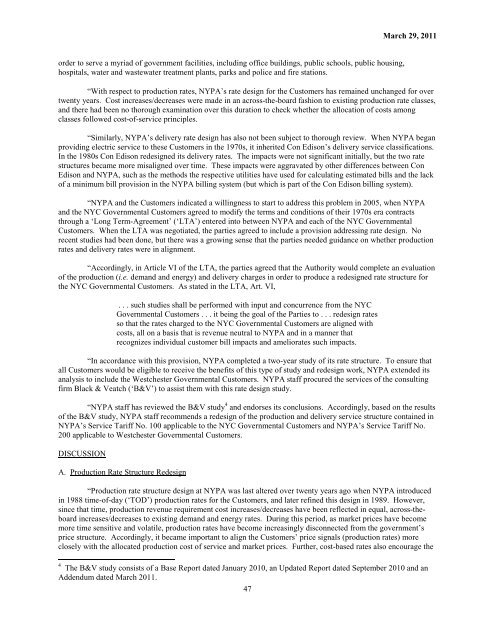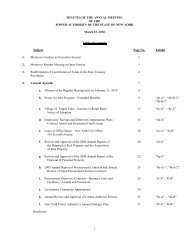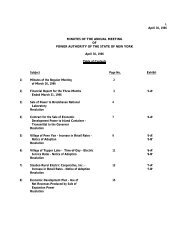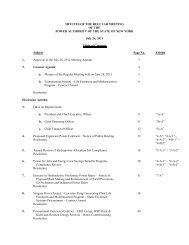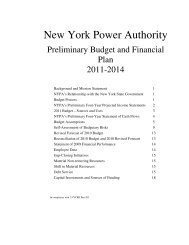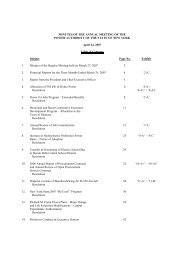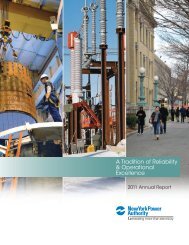March (pdf) - New York Power Authority
March (pdf) - New York Power Authority
March (pdf) - New York Power Authority
You also want an ePaper? Increase the reach of your titles
YUMPU automatically turns print PDFs into web optimized ePapers that Google loves.
<strong>March</strong> 29, 2011<br />
order to serve a myriad of government facilities, including office buildings, public schools, public housing,<br />
hospitals, water and wastewater treatment plants, parks and police and fire stations.<br />
“With respect to production rates, NYPA’s rate design for the Customers has remained unchanged for over<br />
twenty years. Cost increases/decreases were made in an across-the-board fashion to existing production rate classes,<br />
and there had been no thorough examination over this duration to check whether the allocation of costs among<br />
classes followed cost-of-service principles.<br />
“Similarly, NYPA’s delivery rate design has also not been subject to thorough review. When NYPA began<br />
providing electric service to these Customers in the 1970s, it inherited Con Edison’s delivery service classifications.<br />
In the 1980s Con Edison redesigned its delivery rates. The impacts were not significant initially, but the two rate<br />
structures became more misaligned over time. These impacts were aggravated by other differences between Con<br />
Edison and NYPA, such as the methods the respective utilities have used for calculating estimated bills and the lack<br />
of a minimum bill provision in the NYPA billing system (but which is part of the Con Edison billing system).<br />
“NYPA and the Customers indicated a willingness to start to address this problem in 2005, when NYPA<br />
and the NYC Governmental Customers agreed to modify the terms and conditions of their 1970s era contracts<br />
through a ‘Long Term-Agreement’ (‘LTA’) entered into between NYPA and each of the NYC Governmental<br />
Customers. When the LTA was negotiated, the parties agreed to include a provision addressing rate design. No<br />
recent studies had been done, but there was a growing sense that the parties needed guidance on whether production<br />
rates and delivery rates were in alignment.<br />
“Accordingly, in Article VI of the LTA, the parties agreed that the <strong>Authority</strong> would complete an evaluation<br />
of the production (i.e. demand and energy) and delivery charges in order to produce a redesigned rate structure for<br />
the NYC Governmental Customers. As stated in the LTA, Art. VI,<br />
. . . such studies shall be performed with input and concurrence from the NYC<br />
Governmental Customers . . . it being the goal of the Parties to . . . redesign rates<br />
so that the rates charged to the NYC Governmental Customers are aligned with<br />
costs, all on a basis that is revenue neutral to NYPA and in a manner that<br />
recognizes individual customer bill impacts and ameliorates such impacts.<br />
“In accordance with this provision, NYPA completed a two-year study of its rate structure. To ensure that<br />
all Customers would be eligible to receive the benefits of this type of study and redesign work, NYPA extended its<br />
analysis to include the Westchester Governmental Customers. NYPA staff procured the services of the consulting<br />
firm Black & Veatch (‘B&V’) to assist them with this rate design study.<br />
“NYPA staff has reviewed the B&V study 4 and endorses its conclusions. Accordingly, based on the results<br />
of the B&V study, NYPA staff recommends a redesign of the production and delivery service structure contained in<br />
NYPA’s Service Tariff No. 100 applicable to the NYC Governmental Customers and NYPA’s Service Tariff No.<br />
200 applicable to Westchester Governmental Customers.<br />
DISCUSSION<br />
A. Production Rate Structure Redesign<br />
“Production rate structure design at NYPA was last altered over twenty years ago when NYPA introduced<br />
in 1988 time-of-day (‘TOD’) production rates for the Customers, and later refined this design in 1989. However,<br />
since that time, production revenue requirement cost increases/decreases have been reflected in equal, across-theboard<br />
increases/decreases to existing demand and energy rates. During this period, as market prices have become<br />
more time sensitive and volatile, production rates have become increasingly disconnected from the government’s<br />
price structure. Accordingly, it became important to align the Customers’ price signals (production rates) more<br />
closely with the allocated production cost of service and market prices. Further, cost-based rates also encourage the<br />
4 The B&V study consists of a Base Report dated January 2010, an Updated Report dated September 2010 and an<br />
Addendum dated <strong>March</strong> 2011.<br />
47


